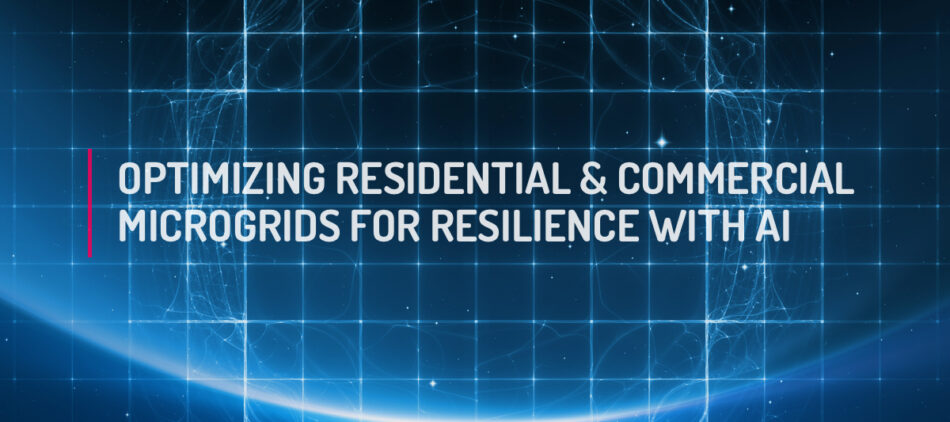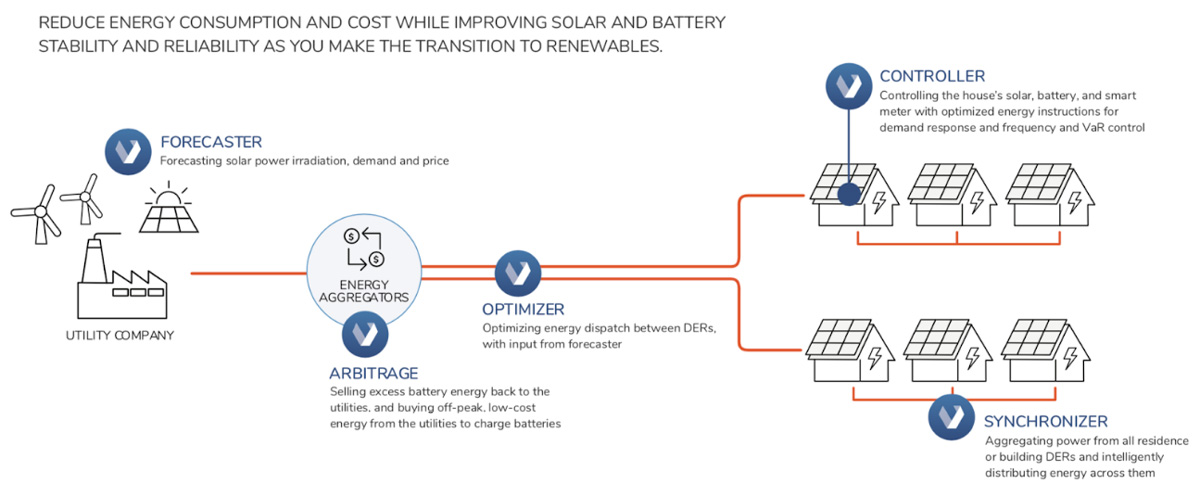
Optimizing Residential and Commercial Microgrids for Resilience with AI
One of the great challenges of managing the US electricity grid is the presence of distributed energy resources (DERs) that are behind-the-meter and beyond the direct control of grid operators. Although residential and commercial investments in solar PV, batteries, and other DERs are helping to make the grid greener, they also create unprecedented headaches for energy providers:
- Solar and wind power are unpredictable, making them difficult to manage efficiently and smoothly.
- Fulfilling peak demand requires large capital outlays and sufficient lead times.
- Energy fluctuations can cause PV system failures, battery malfunctions, and blackouts throughout the grid.
- Energy trading requires real-time data on supply, demand, and pricing to generate profitable returns.
Worse still, utility providers and independent system operators (ISOs) have little control over behind-the-meter assets, which prevents them from discharging batteries or switching to solar when trying to optimize energy use, reduce utility costs, and make the entire grid more resilient . In fact, much of the energy generated behind-the-meter is wasted due to insufficient coordination. The same is true of overstressed devices that have no way of relaying power when and where it is needed most, for example to microgrids and critical facilities during an extreme weather event or other emergency.
Using artificial intelligence (AI) and adaptive machine learning, however, it is now possible to quickly predict, optimize, control, and aggregate energy so that everyone in a residential community microgrid or commercial building receives the right amount of power – at the right time and price. And any energy aggregator armed with this predictive technology will have the power to design, build, and maintain a true Virtual Power Plant (VPP).
What Is a VPP – and How Can AI Technology Get Us There?
A Virtual Power Plant is a decentralized, cloud-based network in which grid operators can control and aggregate power from batteries, solar PV panels, and other DERs when optimizing energy dispatch to nearby residential communities and commercial buildings for greater grid resiliency. This technology also facilitates profitable trading on energy exchanges.
VPPs have long been a pipe dream – simply due to the challenges of analyzing millions of data points across thousands of distributed, connected energy assets. Using humans to achieve this level of coordination is both time-consuming and costly. And with many terabytes of real-time data to manage, the results are often inaccurate.
But with Veritone’s AI-powered suite of energy solutions, grid stakeholders now benefit from faster and more precise results:
- Forecaster software collects real-time weather, load, and pricing data to predict where energy supply and demand are headed.
- Optimizer software uses Forecaster input and sensor data to fine-tune the rules governing energy dispatch across the grid and all distributed energy resources. This process ensures every component system operates at peak performance based on current grid needs.
- Controller software automatically executes Optimizer’s directives to generate, store, or dispatch power in the most efficient way possible – from topping up batteries to pausing PV panels to delivering energy to critical loads, even in an islanding scenario requiring autonomous grid control.

Predictive analysis and real-time control create for a more seamless grid experience for the residential or commercial energy consumer. In addition, using AI to make solar and battery power generation also makes the grid:
- More predictable when peak shaving (i.e. increasing or decreasing energy whenever demand is highest).
- More efficient through DER synchronization and intelligent control of building HVAC and other heating and cooling devices.
- Safer and more reliable – ensuring service levels and resiliency, prolonging equipment life, and enabling voltage stabilization and frequency response.
- More cost-effective, whether delivering energy or trading on the exchanges.
However, there is one final component of Veritone’s AI-powered suite – Arbitrage.
While Forecaster, Optimizer, and Controller work in concert to create a more stable grid for microgrids, residential communities, and commercial buildings, Arbitrage combines these components to deliver unparalleled energy buying, selling, and dispatch capabilities. When you know the price of grid electricity seconds, days, and weeks into the future, you enjoy a competitive advantage on major energy exchanges.
This advanced knowledge allows you to:
- Buy electricity from utilities or wholesale markets whenever prices are low
- Sell when prices go up – including from renewable energy assets you control
Use Cases of Veritone’s Behind-the-Meter Energy Solutions
Below are 3 example applications of how Veritone’s AI-powered solutions can help make the residential and commercial microgrids more optimized and resilient.
1. Demand Response
In a demand response application, the participant or energy aggregator receives an instruction signal from the utility, for instance, “Reduce load by 50 kW.” The Controller responds instantly with an optimized energy level consistent with that instruction.
This real-time, reliable demand response can occur at the energy aggregator level, residential level, or commercial building level, where the aggregator signal is sent to individual residence or building controllers, which in turn control individual energy devices (thermostats, batteries, inverters, etc.).
2. Virtual Power Plant
In a VPP application, a residential community’s solar and battery energy can be aggregated, with the Controller sending energy dispatch instructions based on which residence in the network needs it most, or sending excess battery energy back to the utility. This approach ensures reliable energy delivery at the lowest possible per-residence cost.
3. Commercial Buildings – Smart Sensors
In a commercial building application using smart sensors, Veritone Energy Solutions has the ability to capture and analyze KPI data such as energy use, renewable utilization, etc. Using temperature sensors located inside and outside the building, the solutions can control HVAC and other heating/cooling devices to improve equipment efficiency and lower overall building energy consumption.
Ready to Take Back Control of the Grid?
To learn more about how our AI-powered solutions can help you optimize energy usage in behind-the-meter commercial and residential applications, contact us today.
Further Reading
Webinar Replay: Using Predictive AI to Optimize the Grid
Veritone Announces Energy AI Integration with NVIDIA’s EGX AI Platform
Veritone Extends Its Technology Lead In Renewable Energy Optimization With Three New Patents